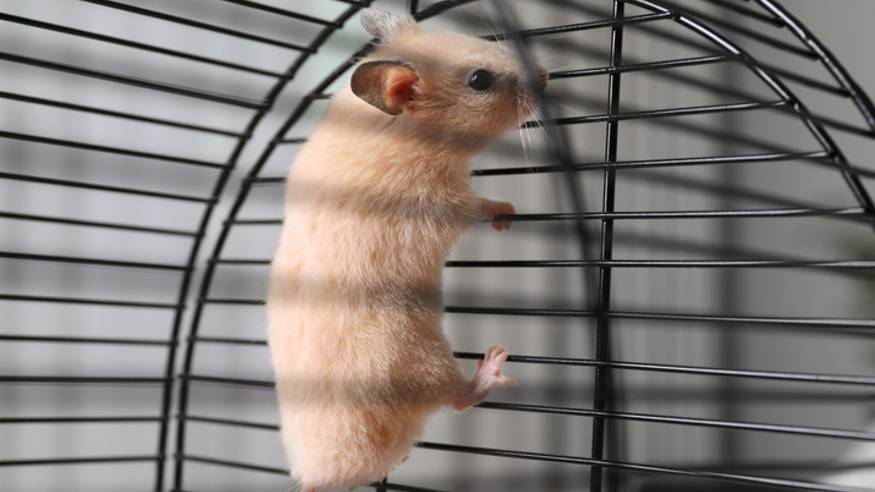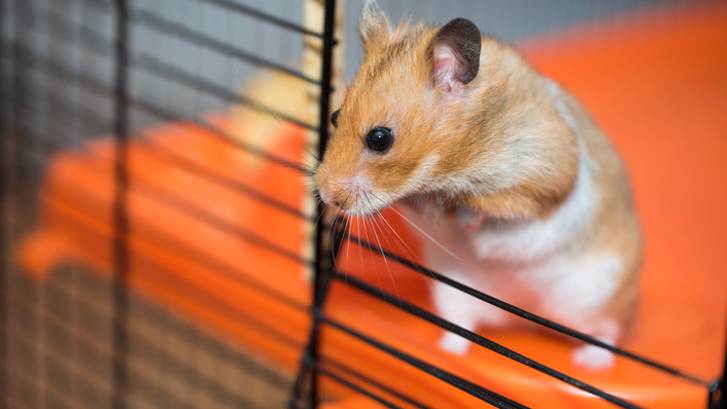Why does my hamster climb the cage? (and how do I stop it?)
Concerned about your rodent buddy’s unusual exercise regime? Find out why hamsters love to climb

If you’ve got a wire cage for your hamster you may have noticed that they love to climb those bars. You might even be impressed by just how fit and agile they seem to be - ask yourself if you could achieve the same thing in human terms!
Many hamster habitats have bars as part of their design, making it easy for lots of light and fresh air to reach your hamster, while keeping them nice and secure inside.
The fact that the bars also act as a bit of a playground may feel like it's a bit of a bonus, but if it pairs with the sight of your hamster biting the cage, you may start to worry your pet is planning The Great Escape instead! It’s only natural to wonder if this kind of behavior is normal, and beyond that, if it’s safe.
In this piece, we’ll be exploring why hamsters love to climb the cage, discovering when it’s not always safe to do and deciphering whether your hamster is happy with the cage set up in the first place.
- How to help a stressed hamster: Vet's guide to symptoms and causes
- How to find a lost hamster
- Why is my hamster biting me?
Should hamsters climb?
In the wild, hamsters climb all the time. These are agile, exploratory little creatures that travel far and wide in the wild, venturing over plenty of different habitats, which will generally include some element of climbing.
Although you may not find something that exactly mimics cage bars in nature, the behavior to climb or scramble is all perfectly normal, and not something to be overly worried about in most instances.
If your hamster is otherwise displaying happy behavior, then you shouldn’t be too concerned, but it's worth keeping an eye on your hamster’s surroundings to make sure they don’t inadvertently hurt themselves or are climbing because they are distressed about something else.
You’ll also probably notice that your hamster jumps or falls from the bars that they are climbing. Again, this is generally not a problem when it’s short distances, and/or if the floor of the cage is well-covered in soft bedding material. You should ensure that any wire sections don’t have a steep drop directly underneath them, and always keep the floor well-covered to cushion any impact.

Why is my hamster climbing or jumping up his cage?
There are lots of reasons why you might find your hamster climbing their cage, and mostly they are nothing to worry about. Some of them can indicate a small problem which is easily fixable, too.
Some common reasons include:
- Natural instinct Hamsters will climb plenty of objects in the wild, so it’s in their nature to do this
- Excess energy If the hamster doesn’t have enough access to other ways to burn off energy, such as a small cage, or no wheel
- Boredom If the hamster doesn’t have much stimulation, such as toys, a wheel, or a small cage, they might try to alleviate boredom by climbing
- Curiosity The hamster might simply know what it’s like to climb, or may reason that it’s the easiest / quickest route to another area of the cage
- Trying to escape Occasionally, a hamster may feel distressed and want to escape from their cage - this is rare and usually only if they have a small or unsuitable cage
How to stop a hamster climbing the cage
Although you shouldn’t be too concerned about your hamster climbing, there are certain reasons why it’s not always optimal behavior. The following changes are worth exploring to ensure your hamster is happy in life.
Rotate their toys
If your hamster has excess energy, it could be that they don’t have enough to occupy them. Make sure they have a good variety of hamster toys available to play with, and perhaps even try switching out the toys on a regular basis to keep their brain as active as possible.
Check your cage size
You should also make sure that your hamster’s cage is as large as you have room for, to give them plenty of space to roam and explore. You might still find that they climb the bars - sometimes it’s just fun for them - but you could also investigate ‘tank type’ hamster cages that remove bars altogether if you’re particularly worried.
If you’re keen to give your hamster an upgrade on their living quarters, don't forget to check out our guide to the best hamster cages.
Encourage burrowing activity
Make sure you also place plenty of burrowing material in your hamster’s cage, as burrowing is another activity that hamsters will carry out to prevent boredom. You could even purchase a digging tower for them to give them a specific place to carry out this activity.
Adding lots of burrowing material to the bottom of their cage has the added bonus of cushioning any falls from the bars should they occur (try not to worry too much about this, hamsters are generally pretty hardy little creatures)
Give them plenty of time outside
You should also make sure that your hamster gets plenty of time outside their cage to play. That could be within a pen you’ve specifically constructed, or just in the hands of their favorite human. Giving them time outside the cage keeps them stimulated and uses up their excess energy, making them less likely to spend time climbing the bars.
How can I tell if my hamster is happy in the cage?
It may not always be super obvious if your hamster is happy with his lot in life - they’re not generally as easy to read as dogs or cats. However, there are a few tell-tale signs which will display if your hamster is contented enough in their cage, or if they long for something else.
The biggest signal of happiness in a hamster is that they are relaxed and happy to show vulnerability. If you see them often grooming themselves, yawning and stretching, then this shows that they're happy in their surroundings and trust that they’re not in any danger.
You’ll also see them displaying other behaviors that show off happiness - such as coming close to the cage door when you’re in the vicinity.
Collecting and storing their food in different areas around the cage shows that they're happy with their living arrangements, while running on wheels and playing with their toys and puzzles also shows contentment. Lastly, burrowing is a happy behavior which generally shows that they’re happy in their environment.
PetsRadar Newsletter
Get the best advice, tips and top tech for your beloved Pets
Amy Davies is a freelance writer and photographer with over 15 years experience. She has a degree in journalism from Cardiff University and has written about a huge variety of topics over the years. These days she mostly specialises in technology and pets, writing across a number of different titles including TechRadar, Stuff, Expert Reviews, T3, Digital Camera World, and of course PetsRadar. She lives in Cardiff with her dog, Lola, a rescue miniature dachshund.

